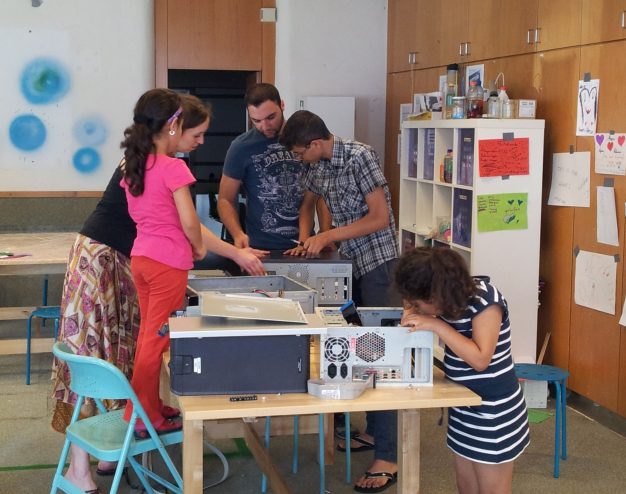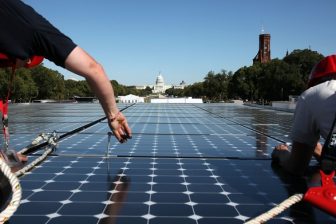
Playful science engagement in pop-up Knowledge rooms
The Knowledge room is a pop-up mini science center, which is set up temporarily in empty shops, former bank branches, or restaurants, in different districts of Vienna, Austria. For a period of two to three months, they become local community and science places where children, but also teenagers and adults can drop in and engage in a large diversity of hands-on, playful activities linked to science and technology, social and cultural topics.
Knowledge rooms are typically located in disadvantaged neighbourhoods of the city, reaching out to individuals and social groups that usually do not visit a science center, museum or other learning spaces. It creates a non-threatening environment and provides low-threshold access to science engagement, making science accessible, understandable, and relevant for them in a playful way.
How does it work?
During the three open days per week, children can just drop by, without having to make reservations and without entrance fees. When they enter, they find a room full of different exhibits, a chill out zone, materials for experiments, a tinkering corner with tools, and boxes with recycled materials like cardboard boxes, wood, old toys, wire, tape, etc.
They can freely choose what they want to engage with from a diverse range of activities. These include exploring different plants or insects under the microscope, learning to write their name in different languages/scripts, building a chain reaction, or improving a car they started to design the day before in the tinkering zone. Specific thematic topics, e.g. the “day of water,” “music and acoustics,” “building bridges,” “electricity and e-textiles,” and the like, create a diverse program even for regular visitors. How visitors engage with the diversity of science activities and experiments is open to them, depending on their curiosity, interest in specific topics, and individual learning pace and time available.
We deliberately offer this diversity of activities to create an open learning space that sparks creativity, fosters innovation and allows visitors to follow their own ideas. Those who feel lost at first, are supported by explainers who host and facilitate the learning processes.
When kids become experts
The main audience in the Knowledge rooms are local kids between the age of 6 and 12, mostly on their own, once their parents have checked out the space. When they become regular visitors, participating several times a week, we begin to see a shift in their self-perception and behaviour. They know some activities, feel competent and want to share their knowledge with others. Like Asam, a 10-year old boy with a Turkish background who loved the microscope and proudly says “I am the professor, I am here every day!“ before he showed his favourite slides to others. Or Raduka, a Serbian girl, who at the age of 9 did not shy away from a group of old ladies, but eagerly taught them how to do an experiment. The highlight of one summer Knowledge room was a science show in the park for the parents – prepared and performed by the regular kids who had been learning a lot while having fun.
The Knowledge°room aims to foster self-empowerment, building confidence in individuals to believe they are someone who knows something, can find out things, and can solve problems. Visitors may experience themselves as curious, competent, and accepted by others, no matter which language they speak and what educational background they have. We have observed that many of the regular visitors adopt a notion of being a “science person,” i.e. of being curious and interested in science, knowing something and being able to explain or help other visitors in experiments and tinkering activities. For most of the children, this makes a difference compared to their usual role and position in school, in the family, and with their friends.
Trusted guidance
Two explainers host a Knowledge°room, taking morning or afternoon shifts. They have a crucial role in making new visitors feel at ease with this open mode of engagement. They help to orientate visitors and support them as they engage. As competent and curious role models, their task is not to teach with a set learning goal in mind. Instead, they try to read and gently guide their visitors as they offer various entry points for self-determined engagement with the experiments, exhibits or with other visitors.
However, the role of the explainers often goes way beyond science learning. Especially for the regular kids, they become trusted contacts who they start sharing personal stories or worries with. We often see that the learning motivation increases when there is also time and space for developing personal relations.
Establishing rules for the spaces has been an issue, but worked well when those were co-designed with the kids so that anyone could refer to them. Kids then quickly accepted and appreciated the differences of the atmosphere at the park, at the youth center or in the Knowledge room and actively chose where to spend their time, depending on their personal mood and preferences.
A space for encounters
Knowledge rooms are located in disadvantaged neighbourhoods, however, they are not exclusively for marginalized social groups, but are open to everyone. A Knowledge room is a place where migrants and non-migrants mingle, where local people meet with people from other districts, who are specifically looking for science learning activities for their children or for themselves.
It is thus a place where people from different social strands may meet unintendedly and through the means of playful science activities may cooperate with one another and get into a dialogue with people from another social or ethnical background. The multilingual and multicultural team of explainers are trained in establishing a mutually respectful atmosphere, promoting intercultural encounters, and initiating cooperative learning experiences. Visitors are encouraged to help each other, or sometimes even to step in as “junior explainers” – and in this role, the regular, local, usually disadvantaged kids can shine. In the Knowledge room, social inclusion and intercultural dialogue are not so much explicit goals, but rather casually develop through the hands-on science activities.
Building bridges
We see a lot of visitors who have never, or very rarely, been to a museum or other informal learning space before and would not actively look for it. The informal atmosphere, the low-threshold access, both literally and on the content-level, and communication at eye-level make them feel at ease. There is no expectancy for their performance, it is allowed and even encouraged to make, mistakes“ and try again without being judged.
Entering a Knowledge room for many of them may be a first, playful step into science activities. And if it is an encouraging and inspiring experience for them, it may build a bridge to other cultural or educational offers or even to a more positive view of learning itself.
If you are interested in finding out more about The Knowledge rooms register for the Child in the City World Conference in Vienna to hear more from Barbara Streicher who is a speaker during the Parallel Session: Access to cultural institutions.
Feature Image: ©Verein ScienceCenter-Netzwerk.




